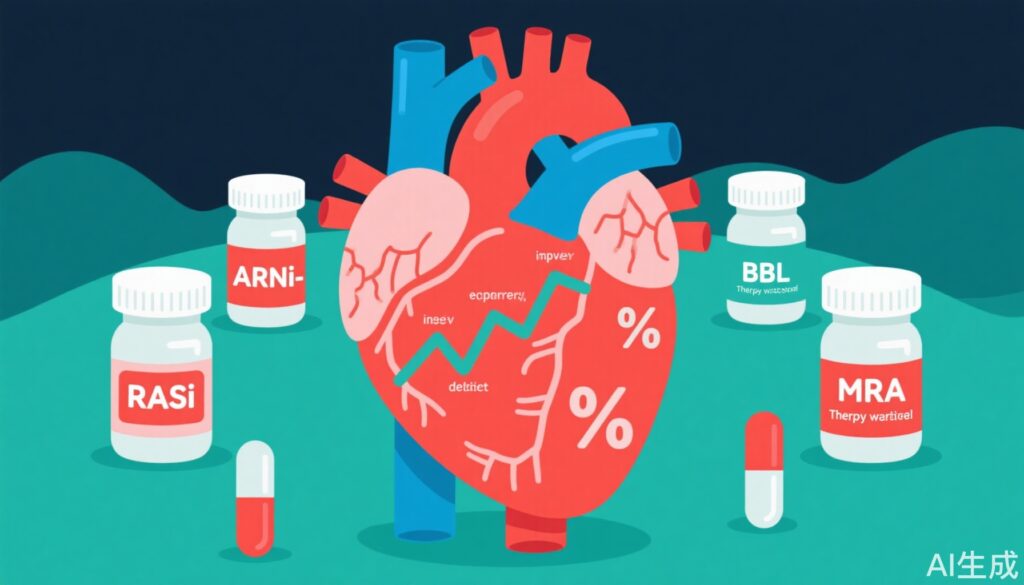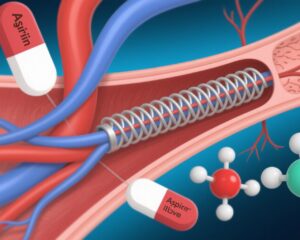Highlight
- Withdrawal of RASi/ARNi and MRA in heart failure patients with improved EF is associated with significantly higher cardiovascular mortality and hospitalization within one year.
- Beta-blocker withdrawal does not show a significant overall association but increases risk in patients with mid-range improved EF (40–49%).
- Withdrawal of heart failure therapies is infrequent but linked to poorer outcomes, emphasizing the importance of continuous treatment.
- Findings highlight an urgent need for randomized controlled trials to evaluate safe withdrawal protocols, particularly for beta-blockers.
Study Background and Disease Burden
Heart failure (HF) affects millions worldwide and remains a leading cause of morbidity and mortality. Optimized guideline-directed medical therapy (GDMT) with agents such as renin-angiotensin system inhibitors (RASi), angiotensin receptor-neprilysin inhibitors (ARNi), beta-blockers (BBL), and mineralocorticoid receptor antagonists (MRA) has substantially improved outcomes. However, a subset of patients experience improved left ventricular ejection fraction (EF), raising clinical questions about the necessity of continuing lifelong pharmacotherapy. The long-term implications of withdrawing medications in this population are yet to be fully elucidated, creating an unmet need to evaluate the consequences on cardiovascular mortality and heart failure hospitalizations.
Study Design
This retrospective observational study analyzed 8,728 patients from the Swedish Heart Failure registry registered between June 11, 2000, and December 31, 2023, who had an initial EF <40% that later improved to ≥40%. Withdrawal was defined as discontinuation of GDMT (RASi/ARNi, BBL, or MRA) between the time of reduced and improved EF registration. The primary endpoint assessed was the composite of cardiovascular mortality (CVM) and hospitalization for heart failure (HHF) within one year, analyzed using a Cox regression model with overlap weighting to adjust for confounding factors.
Key Findings
At the time of initial reduced EF, 96% of patients received RASi/ARNi, 94% beta-blockers, and 46% MRAs. Withdrawal rates at improved EF registration were relatively low: 4.4% for RASi/ARNi, 3.3% for BBL, and 17.2% for MRA.
During a median follow-up of approximately 12 months, 9% of patients experienced the primary outcome (786 events). Crude event rates were higher among patients who withdrew therapy compared with those who continued treatment. Statistical adjustments confirmed independent associations between withdrawal and adverse outcomes:
– RASi/ARNi withdrawal was associated with a 38% increased risk of CVM/HHF (1-year absolute risk difference: 6.0%; number needed to harm: 17; reduced survival by 17.6 days).
– MRA withdrawal carried a 36% increased risk (1-year absolute risk difference: 3.9%; number needed to harm: 25; survival reduction of 11.2 days).
– No significant overall increased risk was noted for withdrawal of beta-blockers. However, subgroup analysis revealed increased risk in patients whose EF improved to 40–49%, suggesting beta-blockers may be particularly beneficial until EF surpasses 50%.
Predictors of withdrawal included a higher EF at the improved assessment, longer intervals between EF measurements, and less concurrent use of other heart failure medications.
Expert Commentary
This large observational analysis confirms that continued RASi/ARNi and MRA therapy is crucial even after EF improvement to prevent HF progression and cardiovascular events. The findings underscore that improved EF does not equate to cure but rather identifies a distinct clinical phenotype requiring sustained treatment. Although beta-blocker withdrawal did not show a general harm signal, the EF-subgroup heterogeneity suggests nuanced clinical decision-making, tailored to individual EF improvement.
Study limitations include the observational design, which is susceptible to confounding despite statistical adjustments, and the single-country registry data, which may affect generalizability. Nevertheless, these data provide valuable real-world evidence supporting continuous GDMT.
Conclusion
Withdrawal of guideline-directed medical therapy, particularly RASi/ARNi and MRA, in patients with heart failure and improved ejection fraction is rare but significantly associated with increased risk of cardiovascular mortality and hospitalization within one year. The relationship with beta-blocker withdrawal is complex and merits further study. These findings highlight the clinical imperative for maintaining appropriate therapy in HFimpEF patients and call for prospective randomized trials to safely guide therapy withdrawal, especially of beta-blockers, as patients recover ventricular function.
References
Basile C, Lindberg F, Benson L, Guidetti F, Dahlström U, Piepoli MF, Mol P, Scorza R, Maggioni AP, Lund LH, Savarese G. Withdrawal of Guideline-Directed Medical Therapy in Patients With Heart Failure and Improved Ejection Fraction. Circulation. 2025 Apr;151(13):931-945. doi: 10.1161/CIRCULATIONAHA.124.072855. PMID: 40091747.



